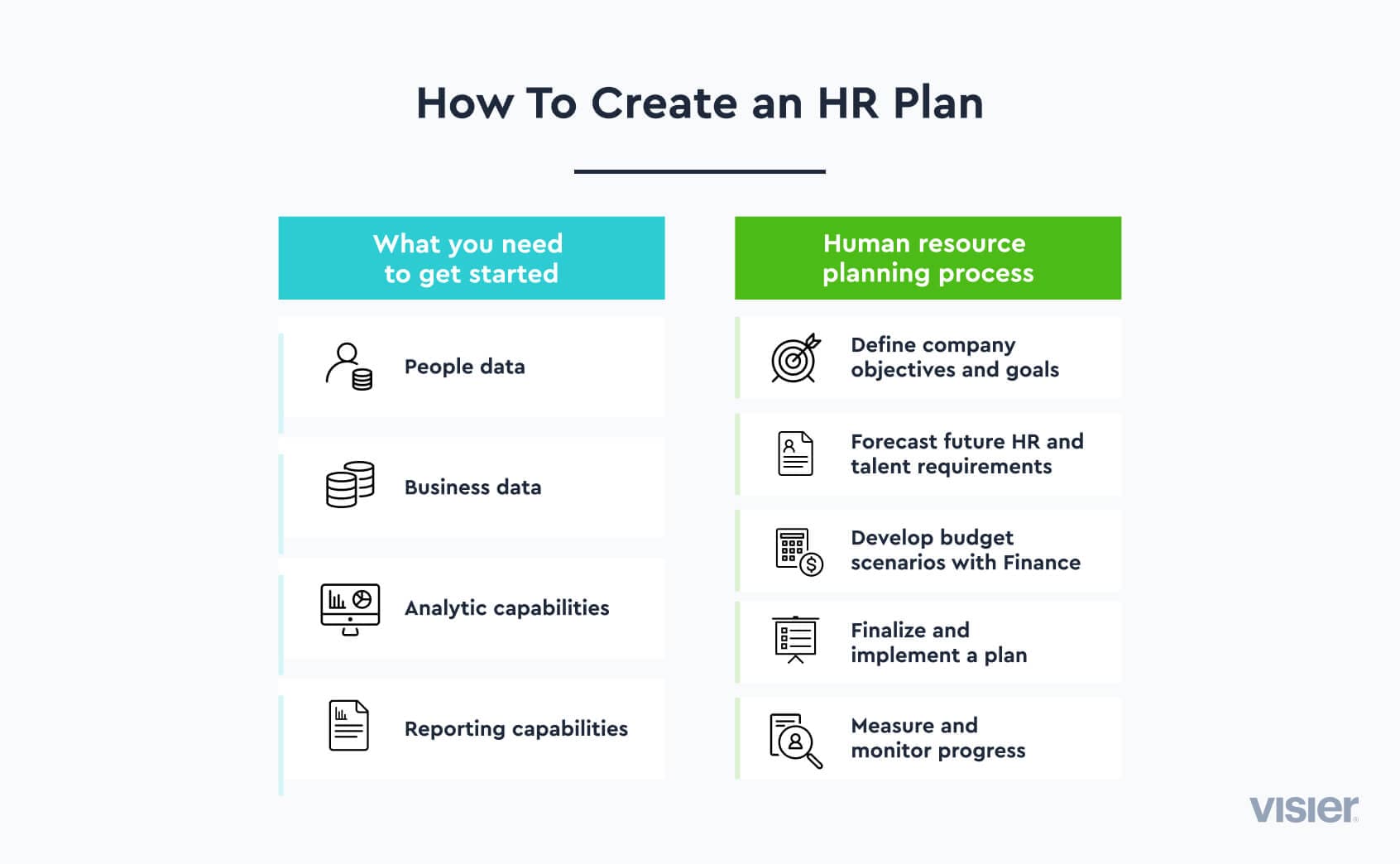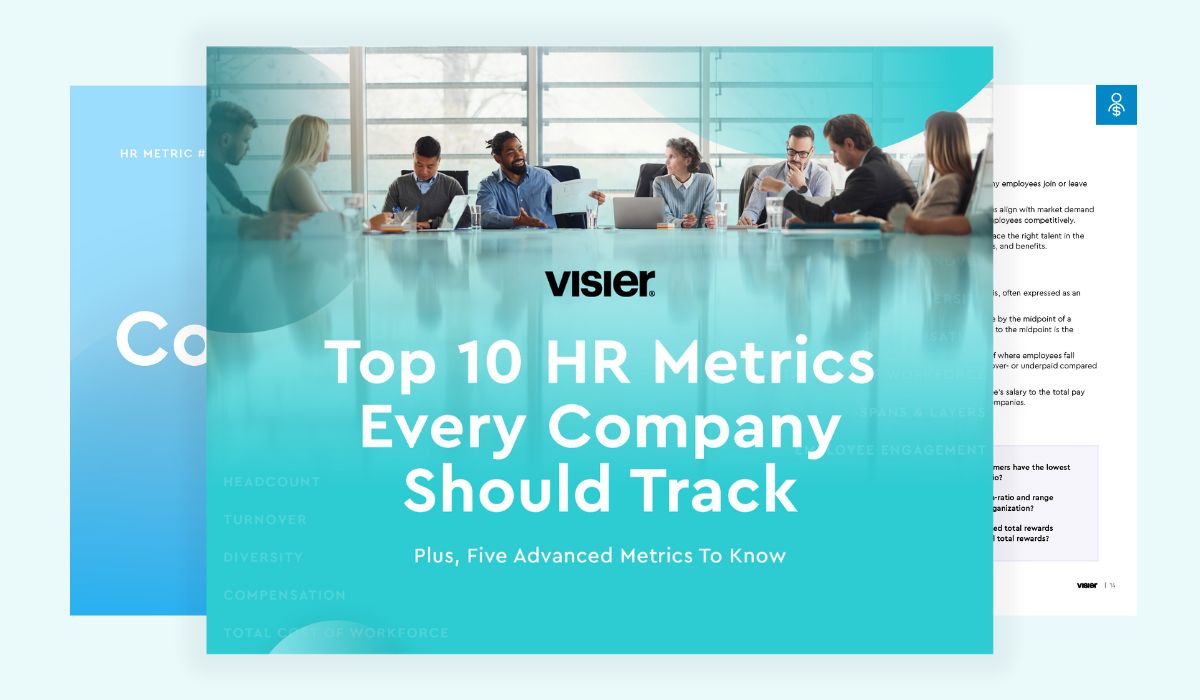HR STRATEGY
How to Use Workforce Analytics for Strategic Human Resource Planning
Effective human resource planning helps organizations proactively adapt and pivot their talent strategies for future needs. Learn more.
Take a tour
Table of contents
What is human resource planning?Key steps of effective HR planningWhat are some examples of human resource planning?What is human resource planning?
Human resource (HR) planning helps organizations identify current and future workforce needs as they relate to the company’s overall strategic priorities. HR planning encompasses the steps and processes that organizations take to properly plan their HR requirements and programs to ensure they’re in alignment with the company’s strategic plan.
HR leaders play an important role in planning for the effective acquisition, development, and deployment of an organization’s human resources. The work that goes into HR planning directly impacts employees as well as organizational leaders, managers, supervisors, and even customers.
The nature of HR planning
Just as R&D and product teams work on their product roadmaps, finance and accounting teams plan how and where to spend and invest corporate funds, and the sales and marketing teams plan how to bring in more revenue, the HR team is also hard at work planning for the future.
HR departments must plan for employment recruitment and retention, training and development, succession, compliance within a dynamic legal and regulatory environment, the advent of new technology like generative AI (GenAI), and much more.
Elements of HR planning
Any business plan involves thinking about the future environment within which the business will operate and trying to predict the challenges and opportunities that will be a part of that environment. With these challenges and opportunities in mind, businesses then think about the best ways to address the challenges and capitalize on the opportunities.
Next, the business must take stock of its current strengths, weaknesses, and general capabilities. Finally, the business creates a plan to move from where it is today to where it believes it needs to be in the future.
This general process applies as much to the HR function as it does to sales, marketing, finance, accounting, product development, or any other corporate function.
Practical applications
HR planners follow the process described above with respect to their particular areas of responsibility. This may include ensuring the company has adequate staff capable of performing the core functions required to keep the business moving, helping the company stay compliant with new legal and regulatory requirements impacting workers and employers, and ensuring company-provided employee benefits can continue and even potentially expand subject to budget constraints.
HR planning involves short-, medium-, and long-term goals and can encompass the general strategic work of a particular HR department or specific, individual plans of varying time horizons.
For example, an HR plan may involve hiring five new customer service representatives by the end of the fiscal year. To achieve this short-term goal, the HR team will need to identify channels through which to market the new position, create and post ads for the positions via those channels, process applications, interview candidates, make job offers, and potentially negotiate with the selected candidates.
The HR planning process involves not only putting together a roadmap, as depicted in the example above, but also creating a target timeline and securing and allocating human and other resources. For example, staff to contact job applicants, money to pay for job ad placement, and the salary to pay a new hire
There are clearly many benefits to HR planning for the company, its employees, and its key stakeholders. While there are also some potential drawbacks of HR planning, these can be avoided with proper preparation, organization, design, and execution.

Benefits of HR planning
First and foremost, HR planning allows organizations to be proactive instead of reactive. A proactive HR department would, for example, be aware of potential regulatory changes impacting the organization well in advance of their effective date. This ensures compliance and opens the door to potentially finding opportunities in the new regulatory landscape.
On the other hand, a reactive company would be caught flatfooted and left scrambling to comply with the new regulations in the nick of time or even after the fact. By identifying and planning for the world of tomorrow, HR teams and the broader organization can capitalize on future opportunities instead of putting out one fire after another.
The ability to be proactive ties directly into the next benefit of HR planning: efficiency. Companies that plan for the future can save time and money when compared to those that simply react. Major expenditures can be forecasted, allowing the company to finance expenses as cost-effectively as possible--even to shop around and wait for more favorable conditions. A reactive organization often pays more for the same resources because it’s forced to adapt at the last minute. This can apply to finding talent, procuring HR software, and anything else an HR department spends money or time on.
Another benefit of HR planning is superior recruitment and retention. The top companies in the world today have reached dominant positions largely due to the talents and abilities of their employees.
Tech giants depend on creative and problem-solving software engineers. Retail powerhouses rely on operations and logistics wizards. Even professional sports teams require top-caliber talent to outmatch their competition. These organizations put tremendous amounts of time and money into HR planning because they know how crucial human capital is to their profitability.
HR planning for recruitment and retention is essential for organizations to be confident in their ability to attract top talent now and in the future and to create a work environment in which employees want to stay.
Avoiding compliance landmines is another benefit of HR planning. The employer-employee relationship is one of the most heavily regulated in our society, and new employment laws are being enacted continuously. New laws can often be extremely complex and require significant organizational change to remain in compliance. Managing such complicated and fundamental changes is impossible without planning in advance.
There are many more benefits of HR planning we could describe here. Still, for the sake of brevity, we’ll add just one last general benefit: the ability to leverage the HR function in pursuing the broader corporate strategy. HR can and should serve as an asset to organizations that can leverage effective HR planning to attract, train, and retain the best talent.

Key steps of effective HR planning
A place for data
People analytics give HR and C-suite leaders the ability to make more data-informed decisions about the development and deployment of their human resources. People analytics is used to turn raw data into meaningful insights that improve the ways companies can make decisions to help grow the business.
People analytics platforms, like Visier, make that process seamless and help to democratize data by putting in the hands of everyone who needs it across the organization. In addition, the data can be displayed in visually pleasing and easy-to-read intuitive charts, graphs, and questions.
Companies also benefit from the application of advanced artificial intelligence (AI), which provides even more sophisticated analysis and content capabilities. With the addition of Visier’s Vee, an AI-powered digitial assistant, organizations can get virtually any questions they might have about their people answered quickly and accurately. Using existing data to help make future predictions can increase the likelihood that planning efforts will be reliable and valid.
Reviewing capabilities
Once an HR team has identified the predicted world of tomorrow, it can think about the capabilities the broader organization will need to thrive in that future environment and how the HR team can help develop those capabilities. Maybe the organization is expected to need more experience in artificial intelligence or automation, for example. Or to downsize or realign parts of the organization to adjust to the impacts of new technologies.
Assessing current state
HR planning also involves taking stock of where a company, its employees, and the HR team are today. This goes beyond the number of employees in certain departments or roles, to also look at demographics, turnover, development, productivity, and a host of other metrics that can provide a more refined and precise understanding of current capabilities and skills gaps.
Creating HR hiring and development plans
Understanding what they have and what they need in terms of talent and competencies, provides the basis for development plans for hiring and developing talent vis upskilling and reskilling to meet current and future needs.
Once a company has a firm grasp of where it is now and where it wants to be in the future, and the talent and capabilities it will need to get there, it can start to develop its roadmap and timeline.
For example, if a company believes it will need to beef up its AI expertise significantly over the next few years, it should start learning about the top sources for candidates and industry-standard compensation for AI professionals and develop job descriptions for key positions.
Measuring and monitoring progress
Finally, HR teams need to identify metrics and create reporting cycles to assess progress and facilitate intelligent changes to the plan as needed. This will ensure that resources are used in the most effective way possible and that decisions are made based on objective data and reasoning.

What are some examples of human resource planning?
Consider an organization planning a large expansion into a new geographic region where it expects to employ around 500 employees. The HR function for this organization would have a lot of planning to do. The HR team would need to:
Understand the employment laws and regulations of this new jurisdiction and work with department heads to identify staffing needs for the new location.
Get to know the local labor market and determine the most effective means of attracting talent.
Plan for large-scale onboarding of new hires.
Next, imagine a company with an older workforce, a large proportion nearing retirement age. This organization’s HR team should be thinking about the looming large-scale attrition of workers and planning to replace those employees and retain as much of their institutional knowledge as possible before they’re gone.
Here are some actual examples of how Visier clients have used data to help them in the HR planning process:
KeHE rolled out Visier to operations managers to increase adoption and swiftly improve business results. In the first year after implementing workforce analytics from Visier, KeHE has experienced massive improvements in turnover analysis, DEI insights, user adoption of data, and more.
Providence, a large healthcare organization with 120,000 employees wanted to determine how raising salaries would affect turnover and what the costs would be. They leveraged historical data and survival analysis to help in their planning process.
Clearly, HR planning is a critical organizational function. Data can make the difference between guesswork and calculated, forward-looking thinking to boost productivity, engagement, and bottom-line results.

Human resource planning should be fundamental to every organization’s strategic plan. Well-conceived and well-executed HR planning helps to drive better recruitment and retention, a skilled workforce, and more. Crafting and executing effective HR planning, however, requires the right tools.
Effective human resource planning is comprehensive, based on a wide range of relevant data inputs, fueled by advanced technologies like AI that can help companies make better decisions more productively, and a process that is ongoing, continually influenced by monitoring key metrics and environmental shifts, opportunities, and threats.
Fortunately, today’s HR leaders and their teams have access to advanced tools and capabilities to make the task less burdensome and more precise. Learn more about how Visier can help you get a workforce AI edge, putting AI-driven insights and guidance – in the right hands, at the right time.



